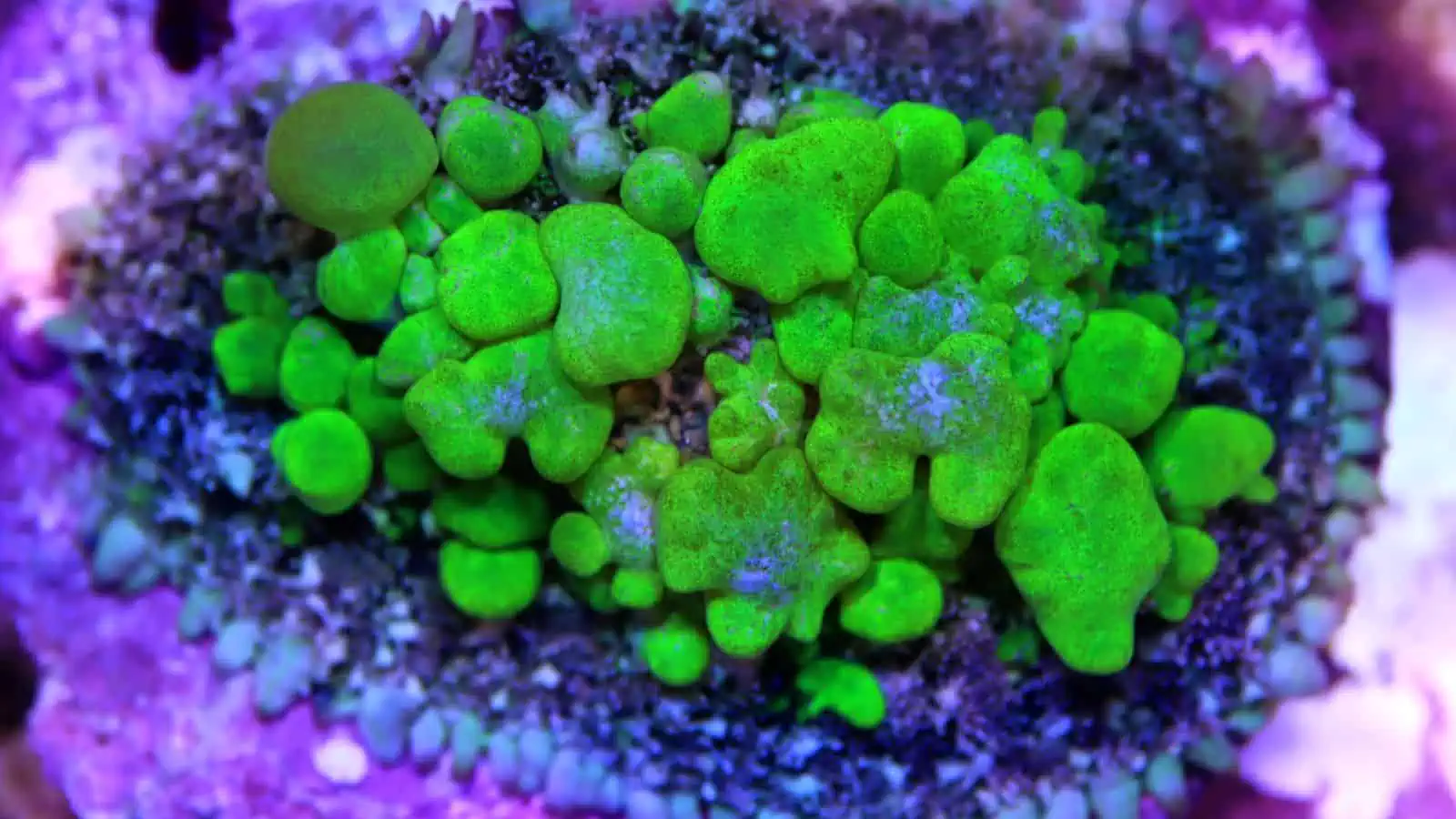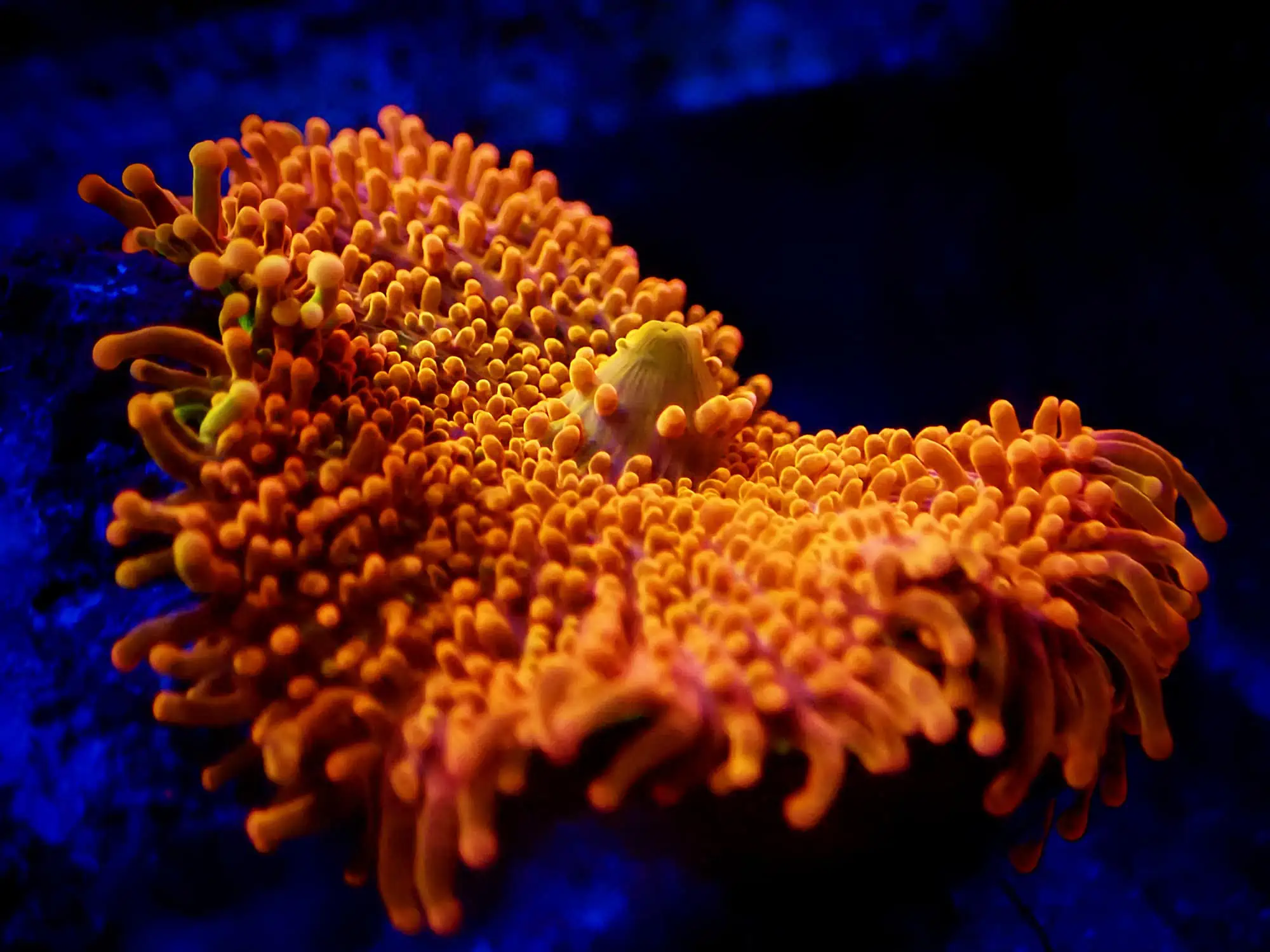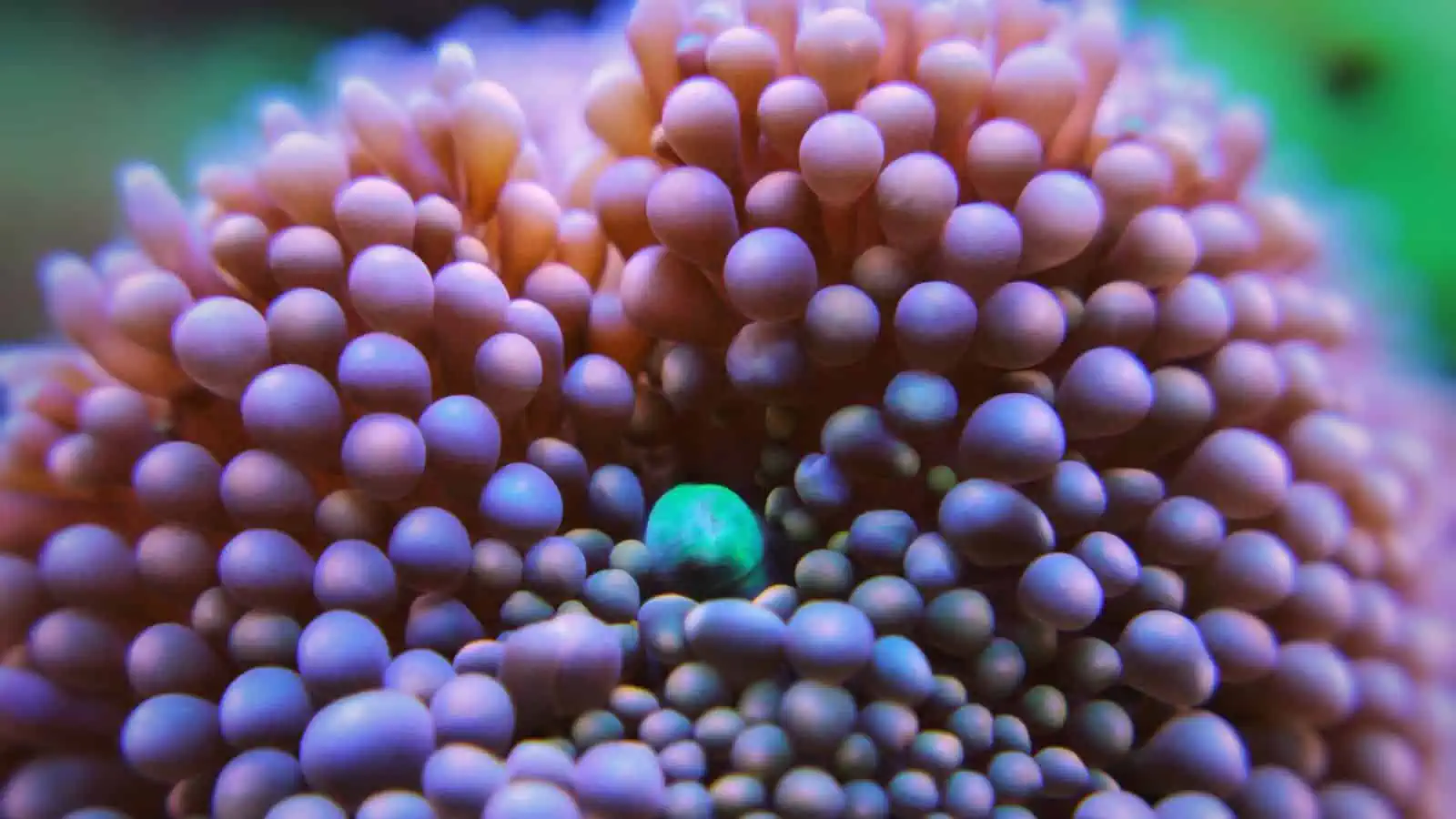The ‘Fungiidae’ or ‘Mushroom Corals’ are a fascinating family of corals that include some of the easiest species of coral for first-time reef keepers to care for.
But this broad and diverse family also includes some stunning coral groups like Ricordia and Amplexidiscus that can be expensive and more tricky to care for, too.
Here we’ll take a look at the vast array of Mushroom Corals, and how best to take care of them.
Mushroom Corals for Reef Tanks at a Glance
| Mushroom Corals Info | |
|---|---|
| Scientific Name: | Actinodiscus, Rhodactis spp. Ricordea spp. |
| Common Names: | Mushroom corals, mushroom anemones, disc anemones, false corals |
| Origin: | Widespread in temperate and tropical waters including Australia, Pacific Ocean Islands, the Caribbean, Indonesia |
| Care Level: | Mostly easier than other types of coral |
| Temperament: | Semi-aggressive |
| Lighting: | Low-Moderate |
| Tank Placement: | Bottom, Middle |
| Filter Flow Rate: | Low for most species |
| Temperature Range: | 76-82 degrees F |
| pH Range: | 8.0 – 8.4 |
| Salinity: | 1.025 (35 PPT) |
| Alkalinity: | 8 – 12 dKH |
| Propagation: | Dividing (Fragging) |
Introducing The Different Types of Mushroom Coral
Because mushroom corals don’t have a hard calcium carbonate skeleton, they can be regarded as ‘soft corals’‘.
This puts them in a different bracket to the more difficult-to-care-for large polyp stony corals (LPS) or small polyp stony corals (SPS).
Let’s take a look at the 5 main groups of mushroom corals.
Discosoma / Actinodiscus

Discosoma mushroom corals are some of the easiest to care for of all types of coral, and they’re also very beautiful!
Their body consists of a round, shiny plate with a mouth protruding at the center. They can be of uniform color or striped in red, blue, green, and metallic colors.
Rhodactis (Including Bounce Corals)

Rhodactis mushroom corals are another very easy group to care for, so they’re great for beginners.
Rhodactis have a fuzzy appearance and come in almost every color you could wish for, including ‘Rainbow rhodactis mushroom’ which exhibits almost every color of the rainbow.
Some of the most famous rhodactis mushroom corals are the bounce mushroom and hairy mushroom subgroups. These quirky names clue us to just how otherworldly these corals can be!
Ricordea

The Ricordea genus comprises two bizarre but beautiful-looking species of mushroom coral: Ricordea florida and Ricordea yuma.
Ricordea are sometimes called ‘mushroom anemones’ because of their bubbly appearance that resembles some anemones. Their incredible colors make them highly sought-after invertebrates.
They’re much easier to keep than anemones but can be trickier than other types of mushroom corals.
Ricordea yuma can be especially challenging, and we’ll talk more about caring for Ricordea in a dedicated subsection later on.
Less Commonly-Kept Mushroom Corals:
Amplexidiscus

Also known as ‘elephant ear anemone’, Amplexidiscus is not an anemone at all, but a true mushroom coral.
This coral’s body consists mostly of a large mouth disc that can reach 16 inches in diameter. An impressive display, Amplexidiscus can fetch high prices in aquarium stores.
Often forming small colonies in the wild, they both photosynthesize and catch marine organisms like crustaceans and small fish in their huge mouths.
Some species of this cunning coral will even produce an alluring scent to coax fish into its reach before closing their mouths around them. Caution should be advised, therefore, when keeping these corals with small fish!
Corynactis / Pseudocorynactis

Corynactis are another fish-eating coral group and are sometimes referred to as false anemones. Species like Corynactis californica, ‘the strawberry anemone’, do possess retractable feeding tentacles to catch their prey, but are not true anemones.
While they are a fascinating family of colorful corals, these aggressive eaters require regular feeding to remain happy. They’re the least commonly kept of all mushroom corals, but their rarity gives them extra appeal to some reef keepers!
Mushroom Coral Care Guide
Mushroom corals are relatively easy corals to care for, but they still require an owner with a good grasp of saltwater aquarium maintenance to keep them happy.
The following notes apply to most commonly kept mushroom coral species, but not Ricordea species, which we’ll discuss at the end.
Tank Size
Because mushroom corals are the least demanding type of coral, they can be kept in small nano tanks. A 10-gallon tank can easily accommodate most mushroom corals.
Lighting
Mushroom corals might be highly robust and adaptable, but they won’t tolerate being exposed to intense light.
These corals prefer low to moderate light and might move into the shadow of a rock if the reef lighting is too bright.
Water Flow
The other thing that mushroom corals won’t tolerate is strong water flow. Try to place them away from the filter outtake and in a more sheltered part of the aquarium, or reduce your filter current.
Some filters allow you to manually adjust the flow rate. On other models, you can reduce the water current by using an aquarium spray bar, or lily pipe.
Mushroom Coral Aggression
Mushroom corals are often thought of as peaceful corals that are well-behaved and don’t move or spread much – but this is not always the case!
Mushroom corals are actually fairly mobile corals that can easily move or spread from one side of a rock to another.
Although mushroom corals don’t have aggressive sweeper tentacles like many hard corals (aka. stony corals) do, they can still attack nearby corals, and potentially win the fight!
For example, it’s been observed that rhodactis (hairy mushroom coral) will dominate over zoanthids and palythoa corals, and may also cause problems for acroporas and acans.
Because of this, it’s a good idea to grow species from different families at least 2 inches apart so that they won’t tangle.
Mounting Mushroom Coral Onto Rocks
The copious amounts of slime exuded from mushroom corals prevent them from being glued onto rocks like other corals. Unsuccessful mounting results in them drifting off and adhering somewhere else where they might be hidden from sight, or grow on top of another coral.
There are various methods to overcome this, generally involving fixing the mushroom coral to the rock with some type of mesh cloth. Never use straps or string directly on top of your mushroom coral, as it will eventually split it in half – a method that some aquarists use to propagate or ‘frag’ established mushroom corals!
Water Temperature

Mushroom Corals accept temperatures from 76-82°F, so are compatible with most tropical reef fish species.
Like fish, corals can be affected by sudden changes in water temperature, so acclimatizing them properly in a new tank is essential to avoid thermal shock.
To avoid unexpected swings in temperature, be sure to install a good aquarium heater with a reliable thermostat, and check your aquarium thermometer daily.
Water Parameters
Mushroom corals are said to prefer water conditions with a pH range of 8.0-8.4, a salinity of 1.025 (or 35 PPT), and a water hardness of 8-12 dKH.
Thankfully, mushroom corals are known for being fairly hardy and so can usually survive in water parameters slightly outside of their ideal range.
Filtration
Hang-on-back filters, internal power filters, or canister filters are all good options, but you should take care not to overwhelm mushroom corals with a strong current.
Some filters allow you to manually adjust the flow rate. On other models, you can reduce the water current by using an aquarium spray bar, or lily pipe.
Photosynthesis
Like many corals, mushroom corals have symbiotic (mutually beneficial) photosynthetic zooxanthellae algae that help to keep them fed.
While the coral is thought to offer a safe home and carbon dioxide for the algae, the algae provide oxygen and sugars in return.
Feeding
Because they photosynthesize effectively, most mushroom corals don’t need extra feeding.
This depends on the species, however, and some mushroom corals will benefit from feeding twice per week with small foods, too.
Compatible Tank Mates
Most mushroom corals are peaceful towards fish and can be kept with a wide variety of reef-safe species.
When mushroom corals feel threatened by their tank mates, they might close up when approached, but with time, they should learn to trust reef-safe fish, shrimp, and snails, and remain open most of the time.
Caring for Ricordea Mushroom Corals

As I mentioned previously, Ricordea corals can be trickier to care for than other mushroom corals. Ricordea yuma, in particular, requires slightly different conditions from other mushroom corals.
One of the reasons that R.yuma is problematic is that it is usually harvested from the wild, rather than raised in captivity. This means it has extra work to do to adapt to an aquarium environment and can be more fussy about tank conditions than other species.
Ricordeas enjoy moderate water flow, and moderate lighting, and prefer to be fed twice per week on small foods of 5-8mm in diameter.
Krill, mysis shrimp, brine shrimp, and bloodworms are all good choices, as well as specially formulated coral foods.
Target feeding with a squirt feeder is recommended to prevent fish and other invertebrates from eating the food first!
To learn more about caring for Ricordeas, I’d recommend this thorough guide.
Propagating Mushroom Corals (Fragging)
Propagating mushrooms is relatively simple, thanks to their power to regenerate from small pieces of flesh.
In the wild, they may sometimes detach a small portion of themselves on a rock as they move, which then grows a new individual polyp.
You can also divide or ‘frag’ them in an aquarium by cutting them down the middle of the polyp’s mouth. Each part will then grow into a new body – a new coral clone!
If your mushroom coral is attached to a rock, you might also need to split the rock in half to divide the coral effectively.
Mushroom corals seem to be very forgiving of clumsy fragging, so they provide a good subject for beginners to learn the art.
Lifespan
According to this scientific study, mushroom corals vary considerably in their typical life span.
While shorter-lived species like Fungia scutaria are only expected to live for around 13 years, others like Ctenactis echinata and Fungia fungites can live for over 40 years!
Of course, the life span of your mushroom corals is proportional to how well you look after them.
While they are relatively robust, they still require the right lighting, water flow, and good water quality to reach their maximum lifespan.
Final Thoughts
Mushroom corals are not only relatively easy to care for, but they’re also an incredibly diverse and beautiful group of corals that will keep you coming back to stare at them in awe and wonder.
Beginners can have plenty of fun caring for Rhodactis and Actinodiscus species, while experts might like to try their hand at keeping Ricordea or even the notorious fish-eating Amplexidiscus types. Good luck!



